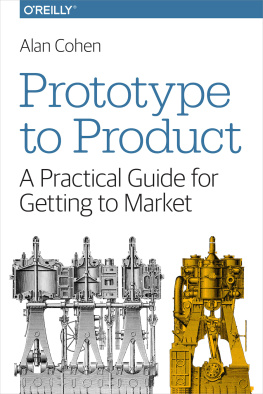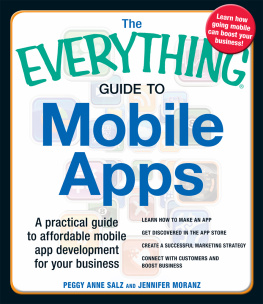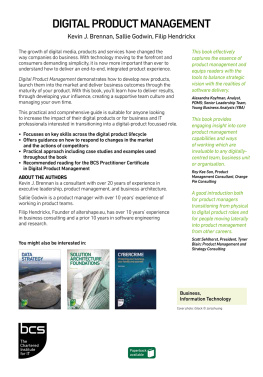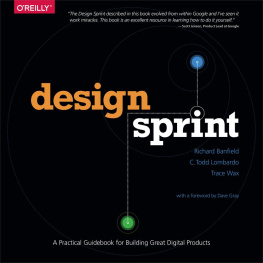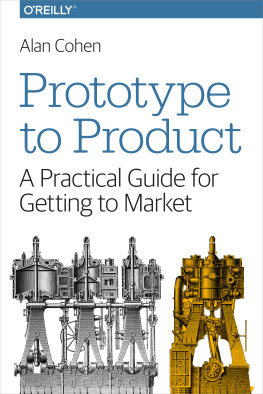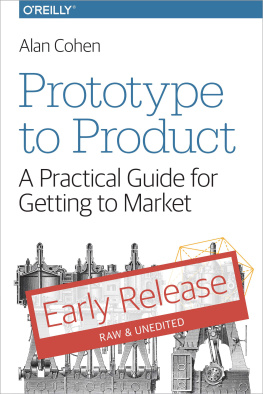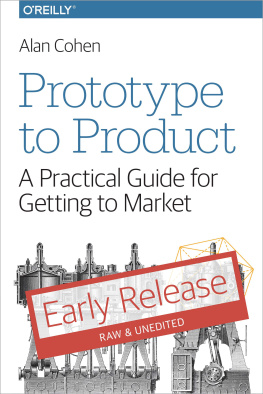Cohen - Prototype to product a practical guide for getting to market
Here you can read online Cohen - Prototype to product a practical guide for getting to market full text of the book (entire story) in english for free. Download pdf and epub, get meaning, cover and reviews about this ebook. City: Sebastopol;CA, year: 2015, publisher: OReilly Media, genre: Romance novel. Description of the work, (preface) as well as reviews are available. Best literature library LitArk.com created for fans of good reading and offers a wide selection of genres:
Romance novel
Science fiction
Adventure
Detective
Science
History
Home and family
Prose
Art
Politics
Computer
Non-fiction
Religion
Business
Children
Humor
Choose a favorite category and find really read worthwhile books. Enjoy immersion in the world of imagination, feel the emotions of the characters or learn something new for yourself, make an fascinating discovery.
- Book:Prototype to product a practical guide for getting to market
- Author:
- Publisher:OReilly Media
- Genre:
- Year:2015
- City:Sebastopol;CA
- Rating:3 / 5
- Favourites:Add to favourites
- Your mark:
- 60
- 1
- 2
- 3
- 4
- 5
Prototype to product a practical guide for getting to market: summary, description and annotation
We offer to read an annotation, description, summary or preface (depends on what the author of the book "Prototype to product a practical guide for getting to market" wrote himself). If you haven't found the necessary information about the book — write in the comments, we will try to find it.
Prototype to product a practical guide for getting to market — read online for free the complete book (whole text) full work
Below is the text of the book, divided by pages. System saving the place of the last page read, allows you to conveniently read the book "Prototype to product a practical guide for getting to market" online for free, without having to search again every time where you left off. Put a bookmark, and you can go to the page where you finished reading at any time.
Font size:
Interval:
Bookmark:
by Alan Cohen
Copyright 2015 Alan Cohen. All rights reserved.
Printed in the United States of America.
Published by OReilly Media, Inc. , 1005 Gravenstein Highway North, Sebastopol, CA 95472.
OReilly books may be purchased for educational, business, or sales promotional use. Online editions are also available for most titles (http://safaribooksonline.com). For more information, contact our corporate/institutional sales department: 800-998-9938 or corporate@oreilly.com .
- Editors: Mike Loukides and Meghan Blanchette
- Production Editor: Melanie Yarbrough
- Copyeditor: Gillian McGarvey
- Proofreader: James Fraleigh
- Indexer: Wendy Catalano
- Interior Designer: David Futato
- Cover Designer: Karen Montgomery
- Illustrator: Rebecca Demarest and Melanie Yarbrough
- August 2015: First Edition
- 2015-08-10: First Release
See http://oreilly.com/catalog/errata.csp?isbn=9781449362294 for release details.
The OReilly logo is a registered trademark of OReilly Media, Inc. Prototype to Product, the cover image, and related trade dress are trademarks of OReilly Media, Inc.
While the publisher and the author have used good faith efforts to ensure that the information and instructions contained in this work are accurate, the publisher and the author disclaim all responsibility for errors or omissions, including without limitation responsibility for damages resulting from the use of or reliance on this work. Use of the information and instructions contained in this work is at your own risk. If any code samples or other technology this work contains or describes is subject to open source licenses or the intellectual property rights of others, it is your responsibility to ensure that your use thereof complies with such licenses and/or rights.
978-1-449-36229-4
[LSI]
Dedicated to the men and women who participated in the greatest engineering project in modern times, the US effort to land people on the Moon by 1969, back when I was a tot. It was an enormous project, it was rapid, and it worked; I am in awe. And, in particular, to Dan Hunter, a member of the NASA team from projects Mercury through Apollo, and a fine friend. Dan was the coolest guy Ive ever known, and is sorely missed by many.
Product development is the magic that turns circuitry, software, and materials into a product. The word magic here is not used by accident; for most folks who design and develop technology as a hobby or even professionally, creating new products is unknown territoryor magicas far as they are concerned.
This books goal is to help the reader to gain a better understanding of the stuff that happens along the way when great ideas metamorphose into great productsin particular, intelligent products with embedded electronics and softwareand to supply strategies and tactics to make that stuff go more smoothly.
Creating an intelligent product is complex. Its much more than developing some circuits and software, plopping em into a case, and hanging out a for sale sign. Numerous activities must be performed to turn components and cool prototypes into a desirable, usable, reliable, manufacturable, and salable product.
In part because of the complexity, new product development is a risky undertaking. According to Harvard Business School Professor Clay Christensen, 95% of new products fail. A number of factors play into this high rate, but Ive experienced firsthand that many or most new product failures stem from failures in the product development process.
For example, notoriously, most product development efforts end up being late and over budgetoften by substantial amounts of 25% or more. Even a 100% overrun is not unusual. Sometimes overruns are caused by simply not estimating effort correctly. They often also come from surprise re-development efforts, which become necessary because product needs were not well known early in development. In my experience, these overruns and surprise re-development efforts often stem from flaws in the productization process, not from the fundamental technology involved.
Budget and timeline surprises in the product development process are usually quite avoidable. They normally come from a lack of knowledge about the process, particularly the failure to realistically plan for productization stuff early in the process, and a lack of complete and clear requirements.
But proper product development is about more than avoiding overruns; it can also play a key role in refining a great concept into a desirable product. For example, when the Palm Pilot was released in 1996, most folks in the technology biz knew that the concept of a computer-in-your-pocket was a dog. A slew of pocketable computers had come and gone, including Apples Newton, and all had bombed. Couldnt be done.
The Palm Pilot proved the technology biz wrong: it was a raging success. Much of this success came from a smart product development process where the right kinds of testing were done at the right stage of the process to ensure that the technology Palm developed solved real problems and fit into real lives (well touch on the Palms process a bit more in ). While Palm failed to stay ahead of its competition, its paradigm for pocket computing lives on in todays smart phones, which look much more like a Palm Pilot than, say, an Apple Newton.
Many books do a great job of covering parts of product development, such as electronic design, software development, industrial design, usability, and mechanical engineering. There are a handful of books that cover product development at a business level, reviewing topics ranging from market research, to financial forecasting, to team dynamics. But very little has been written that covers, holistically, the nuts and bolts of efficiently moving from good ideas to manufactured product, and thats what I hope to do with this book.
Even though my formal education and background is in electronics and software, my role in projects is generally as a systems engineer.
Systems engineering is a field that considers how the different parts of complex systems work together to accomplish their purpose. Were commonly the technology people who lead the effort to produce an actual product, rather than circuits and software in an enclosure. In a sense, we could be called holistic engineers, because were responsible for the whole system working together as a product.
At the purely technical level, we systems engineers lead the effort to plan, at a high level, how a desired set of properties (requirements) can be broken down into subsystems that efficiently get the job done, with an eye toward minimizing time, cost, and risk. Once these subsystems and their functionality are defined, we try to make sure that development continues to proceed in a way that enables all of the subsystems to work together in the final product.
On a day-to-day basis, my job normally consists of bringing together groups of people with varying backgrounds, and helping us all to move toward our common goal. I typically work with engineers from various disciplines (electronics, software, mechanical, etc.), industrial designers, management, marketing, sales, regulatory, finance, manufacturing, and others. Successful product development requires all of these folks to work together effectively for months or years, and systems engineers (along with project managers, whose role we sometimes fill) tend to act as the lubricant to keep things running smoothly.
There are two tasks that tend to catalyze these disparate groups of people into a cohesive team:
Font size:
Interval:
Bookmark:
Similar books «Prototype to product a practical guide for getting to market»
Look at similar books to Prototype to product a practical guide for getting to market. We have selected literature similar in name and meaning in the hope of providing readers with more options to find new, interesting, not yet read works.
Discussion, reviews of the book Prototype to product a practical guide for getting to market and just readers' own opinions. Leave your comments, write what you think about the work, its meaning or the main characters. Specify what exactly you liked and what you didn't like, and why you think so.

